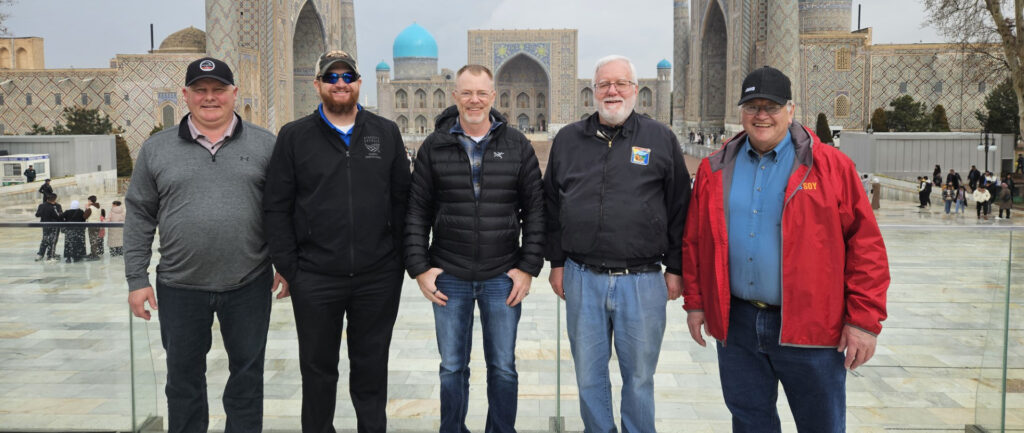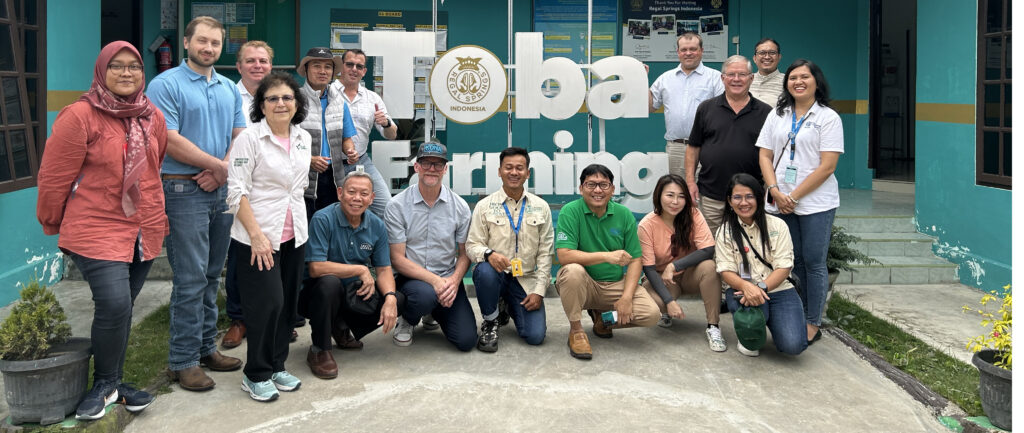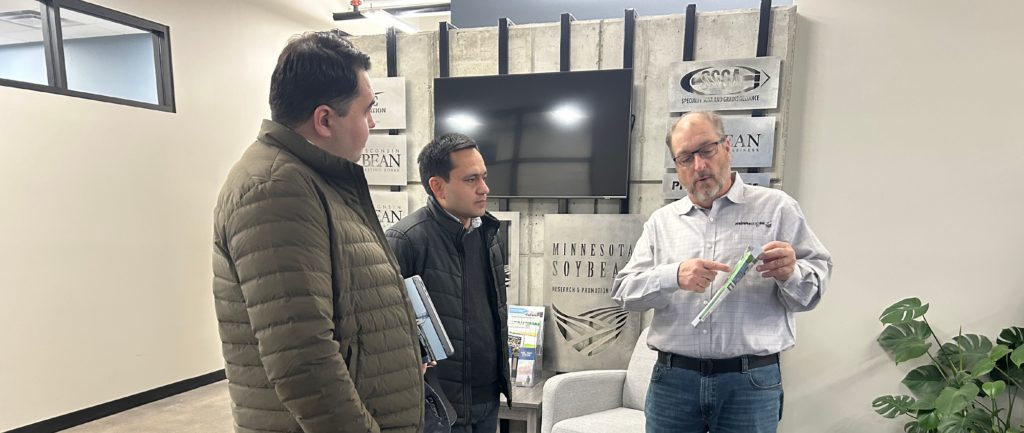This article first appeared in the April-May 2018 issue of Soybean Business. Click here to view the digital version of this issue.
The production cycle for many soybean farmers begins in the field and ends when the last load is brought to the elevator. Looking beyond the elevator can be hard to imagine until given the opportunity to see end-users and international customers firsthand.
In early February, 10 Minnesota and three North Dakota soybean farmers were able to see just that.
As part of the See For Yourself program, hosted by the Minnesota Soybean Research & Promotion Council (MSR&PC) and held tentatively every other year, participants were able to meet large buyers of U.S. soybeans, tour emerging markets and see for themselves where soybean checkoff dollars are invested overseas.
“As a soybean farmer, we bring our soybeans to the local elevator and don’t know exactly where they end up,” says Rodd Beyer, a Wheaton, Minn., farmer and participant on this year’s MSR&PC See For Yourself mission. “Being given this opportunity has allowed us to meet those who rely on our quality product and see what my checkoff dollars are doing to promote our product in other countries.”
This year, the group traveled to Chile and Colombia, both with two very different markets.
“Chile is unique. First, it is home to the University of Minnesota soybean research plot, used for wintertime growing by soybean breeders,” says Patrick O’Leary, MSR&PC chairman, who was also a part of the destination decision making. “Second, the aquaculture market is one the soybean industry has kept its eye on.”
Colombia was selected for their dependence on U.S. soybeans.
“Colombia is the third largest importer of U.S.-origin soybean meal and the fifth-largest importer of U.S.-origin soybean oil,” O’Leary says. “They’re a rapidly-growing market and a real, genuine success story for U.S.-Colombian cooperation.”
Chile: Small market, big potential
Chile’s status in terms of salmon exports and production is hard to grasp, holding the position as No. 1 and No. 2 in the world, respectively. Just behind Norway in salmon production, the market potential for U.S. soybeans is emerging.
“In 2017, Chile was the world’s fourth-largest importer of U.S.-origin soy protein concentrate,” O’Leary says. “Salmon feed manufacturers consumed 5,000 tons of U.S-origin soy protein concentrate. This is one market we look to grow.”
Even though salmon doesn’t consume a large amount of feed compared to pigs and turkeys, a market is a market, says Clarks Grove, Minn. farmer and See For Yourself participant Jerry Demmer.
“In today’s farm economy, every market for soybeans matters,” Demmer says. “Salmon may not consume a large amount of feed, but it is still an emerging market and an opportunity to get more of our beans off of the market. Big or small, they all matter.”
While in Chile, the group was able to tour the two-year-old Cargill Salmon Innovation Center, the most advanced center in the world. Currently, the facility researches salmon disease and nutrition. Among this, the farmers were able to see a salmon hatchery, farm and processing plant.
A rising star
Traveling just above the equator, the group also toured checkoff investments in Colombia, which holds potential for U.S. soybeans.
“The U.S. is a major supplier of feed needs for Colombia and the leading destination for U.S. agricultural exports in South America,” Beyer says. “Our presence in Colombia runs deep and shows when meeting with top companies and buyers of our product.”
Demmer agrees.
“We had the chance to meet with the No. 1 and 3 importer of U.S. soybean meal. They praised us for our product.”
Much of the success seen in Colombia comes at the hands of the U.S. Soybean Export Council’s (USSEC) presence in Colombia and their goal to build a preference for U.S. soy and soy products in international countries by differentiating U.S. soy.
“Colombia is a very competitive market,” says Kevin Roepke, USSEC regional director for the Americas. “As you can see when looking at a map, Colombia is a unique country for the fact they have access to both the Atlantic and Pacific Ocean, so it has ports on both sides.”
Roepke says Colombia is also unique because much of its population is concentrated in two cities – Bogota and Medellin. The country also suffers from logistical challenges due to the Andes Mountains and deals with corruption around its ports.
“The corruption directly affects agriculture,” he says. “The guerrilla groups will block the ports, making it very difficult to move the product.”
Even though Colombia has its challenges, Roepke says the growth and opportunity is still there.
“Colombia comes with many opportunity and challenges,” he says. “But they are a tremendous success story for U.S. soybean farmers. There’s no better place to learn about the competitiveness of U.S. soy than in Colombia.”
USSEC, funded in part by the soybean checkoff, represents soybean farmers through a network of international offices.
Trade matters
While President Trump looks to renegotiate NAFTA, Colombia is also at risk of losing its free trade agreements, depending on the outcome of their March presidential election.
“There are two presidential candidates against free trade,” Roepke says. “This could be detrimental to the success we’ve seen between the U.S. and Colombia.”
The Free Trade Agreement between the U.S. and Colombia was implemented in 2012. Since then, the U.S. went from 17 to 43 percent of the market share. Roepke says the trade agreement has kept U.S. soy competitive with countries like Argentina.
“We aren’t the only ones dealing with fair trade as a political issue,” Beyer adds. “It’s in other countries too.”
Growing pork market
Colombia will look to U.S. soybean farmers as they continue to increase their pork production and consumption, says Carlos Maya, executive director of Pork Colombia, the country’s checkoff organization. The issues standing in their way are nothing new to U.S. pig farmers.
“Our industry has dealt with a bad image and misconceptions,” Maya says. “We have invested checkoff dollars to improve the perception of our pork industry and increase consumption per capita.”
Pork Colombia has 550 producers associated with the organization. These farmers, regulated by the government, pay into the checkoff. In 2011, the producers went to Congress and asked for a checkoff increase.
“This is very, very strange here in Colombia,” Maya sayss. “They (pig farmers) essentially wanted to pay more taxes. But they did so because they believe in this instrument, where we can help grow the market and improve our sanitary status.”
Today, Colombian pig farmers pay more than two dollars per head to the checkoff. Pork Colombia has invested much of this into campaigns, trying to create awareness.
“Our association sometimes looks more like an advertising agency,” Maya says. “But we want to understand consumers and their decisions. Colombia used to average three to four kilos of pork per capita. Last year, we average 9.3 kilos per capita. We are growing, and growing fast.”
Maya says Colombian pork producers are looking to double their production in the next six to seven years, even with the U.S. Free Trade Agreement and their ability to import pork with zero tariffs.
“Those are big numbers,” Maya says. “And we will need to feed those pigs.”
The U.S. is ready, Beyer says.
“As Colombia continues to promote pork and increase their production, this will also increase their need for more feed,” Beyer says. “The U.S. is ready to supply their demand.”
While in Colombia, the group visited COLANTA, the largest meat processing plant outside Medellin and a dairy facility where they make yogurt and cheeses.
The group returned to the states Feb. 11 and have been sharing what they learned with local radio stations and newspapers.
“We hope this program gave participants an understanding of the many and diverse ways in which soy checkoff dollars are being spent to both expand existing overseas market segments and capture new market segments,” O’Leary says. “There’s nothing better than seeing it firsthand.”
Beyer agrees.
“It’s an eye-opening experience,” Beyer said. “It makes you think beyond the local elevator. Other countries rely on our product, and I now understand why we need to continue building relationships and investing our time and energy into promoting our beans overseas.”







